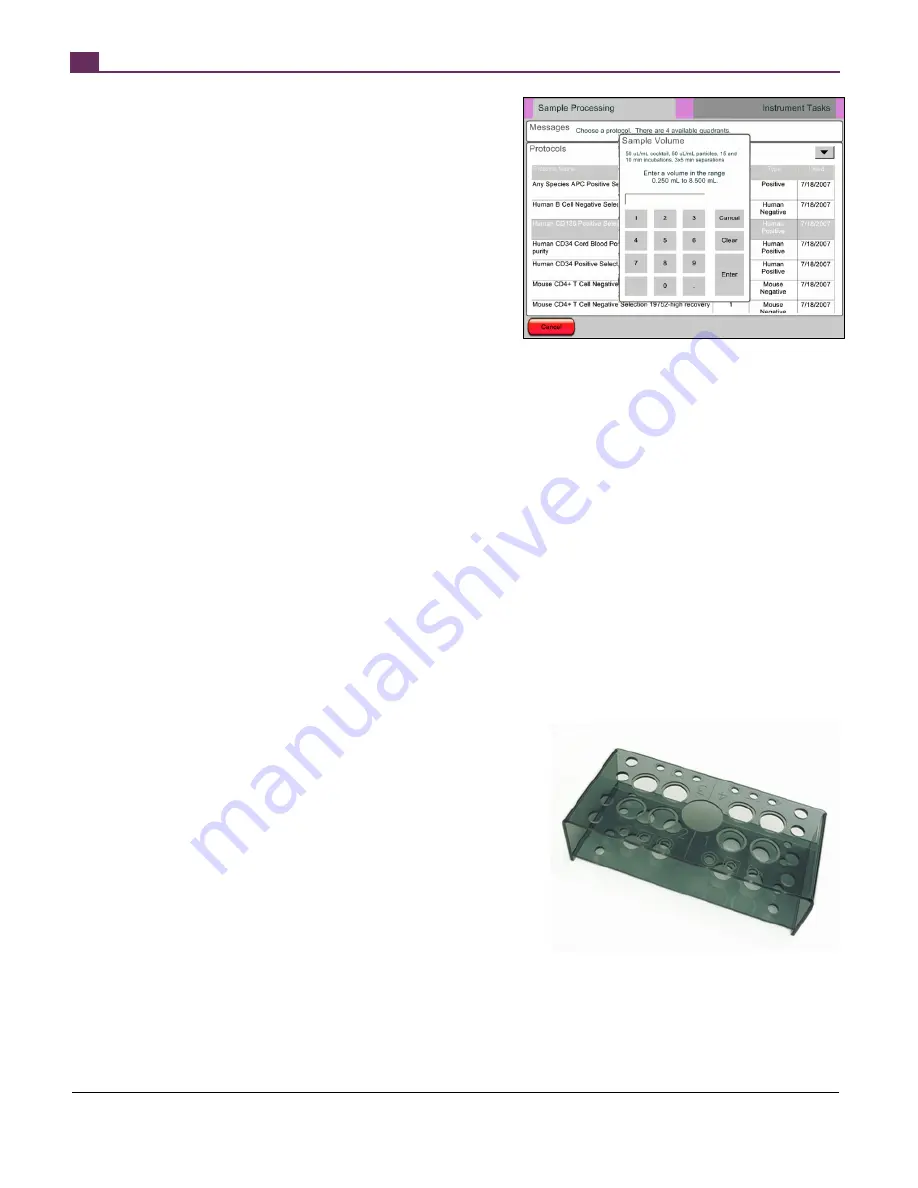
THIS PRODUCT IS MANUFACTURED AND CONTROLLED UNDER A QUALITY MANAGEMENT SYSTEM CERTIFIED TO ISO 13485 MEDICAL DEVICE STANDARDS.
FOR RESEARCH USE ONLY. NOT INTENDED FOR HUMAN OR ANIMAL DIAGNOSTIC OR THERAPEUTIC USES.
TOLL FREE PHONE
1 800 667 0322
y
PHONE
+1 604 877 0713
VERSION 2.4.0
y
y
FOR GLOBAL CONTACT DETAILS VISIT WWW.STEMCELL.COM
DOCUMENT #28940
8
c. Key in the sample volume in mL, and press the
“Enter” key. The original “Sample Processing” screen
will re-appear with the selected protocol in the
appropriate quadrant row.
Note: A short description of the protocol appears in the Samples area.
2. Review/edit the information:
a. To remove the protocol, press the “X” in the last
column.
b. To change the protocol, press the protocol name and
repeat the protocol selection process above.
c. To change the sample volume while keeping the
same protocol selected, press the sample volume for
this protocol, and enter a new volume (Figure 12).
3. Repeat the protocol selection process until all the desired
protocols are entered.
Up to four protocols can be chosen (they can be the same or different). When a negative selection protocol with two rounds of
separation is selected, the interface automatically assigns two adjacent quadrants for the protocol. Once three quadrants are occupied,
only protocols that use one quadrant will be displayed.
Protocol Order
The protocols are listed in order of last use, with the most recently used protocols at the top of the list (Figure 11). The protocols can
also be sorted by name or type. To change the basis of sorting, touch the appropriate column heading. For example, to sort protocols
in alphabetical order press the Protocol Name heading. An arrow in the heading indicates if the list is sorted in ascending or
descending order; touch the column heading again to toggle between these two options. The user can move up and down the list by
using the arrows at the top right corner of the protocols window.
2.2.3
Preparing Cells
Refer to the Product Information Sheets that come with your EasySep™ reagents and/or magnet for instructions on how to prepare
cells for separation using RoboSep™. It is important to use the recommended cell concentration for best results. Ideally the sample
should be a single cell suspension. However, RoboSep™ tips will not clog if small aggregates are present.
2.2.4
Reagents and Resources
The sample tube and separation tube are 14 mL (17 x 100 mm) round-bottom
tubes. We recommend Falcon™ 14 mL Polystyrene Round-Bottom Tubes (BD
Biosciences, Catalog #352057). The waste tube and negative fraction tube/lysis
buffer tube are 50 mL conical bottom tubes (e.g. BD Biosciences, Catalog
#352070). The Service Rack (Catalog #20101) is provided to hold the reagents
and sample prior to loading them on the carousel and to keep track of the caps
during a run (Figure 13). Like the carousel, the rack is laid out in quadrants, with
symbols on the reagent storage locations to assist with keeping tubes together
with the correct caps (
c
corresponds to the Magnetic Particles vial;
corresponds to Selection Cocktail vial;
z
corresponds to Primary Antibody vial).
Figure 12 – Entering sample volumes
Figure 13 – The Service Rack is divided into quadrants and
features symbols on the reagent storage locations to assist
keeping tubes together with the correct caps.
Summary of Contents for RoboSep 20000
Page 1: ...RoboSep The Fully Automated Cell Separator T E C H N I C A L M A N U A L V E R S I O N 2 4 0 ...
Page 33: ......
Page 34: ......
Page 35: ......




























